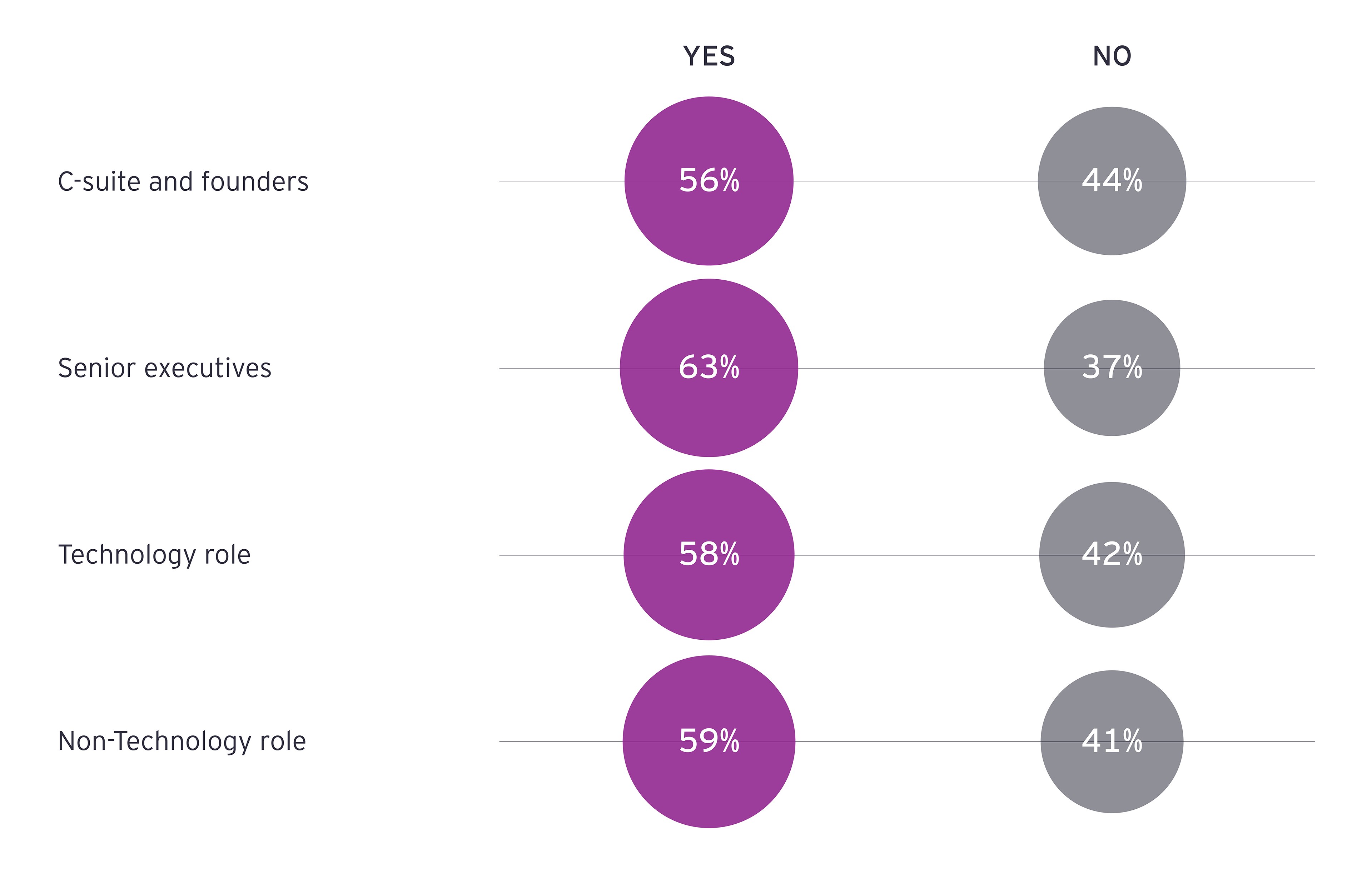Leaders are 50% more likely to annually see EBITDA increase by more than 15%.
- Leaders are 45% more likely than laggards to unlock annual revenue growth of more than 10%.
- Leaders are 26% more likely than laggards to enjoy an annual gross profit increase by more than 10%.
- Leaders are 50% more likely than laggards to annually see EBITDA increase by more than 15%.
Being a leader, or forming the six habits, does not guarantee financial success, but we found strong links between these actions and better financial performance. And we’ve identified those causal links to be three new dimensions of value creation in the Transformative Age.
- Humans@center
A radical commitment to deeper customer centricity and employee engagement - Technology@speed
An intention to deploy technology much faster in order to meet customer and employee expectations - Innovation@scale
The need to be more nimble and to implement major changes to existing business models on a large scale
All three go hand-in-glove with the six habits of digital transformation leaders. Humans@center links with Habit 1, focusing on customers first and foremost, and Habit 4, nurturing talent with new incentives and strategies. This critical value driver connects with the wider idea of the Human Enterprise, our vision of how organizations reframe the role of technology to unlock human ingenuity, resourcefulness and diversity to create new solutions, ideas and business models for tomorrow’s working world. Technology@speed links with Habit 2, accelerating AI to drive growth, and Habit 6, powering innovation by leveraging data and being agile, and innovation@scale ties into Habit 3, driving innovation through ecosystems and partnerships.
Finally, Habit 5, which focuses on good governance, underpins all three value drivers. Without good governance, humans@center, technology@speed and innovation@scale are not possible. The dimensions of value creation, the Human Enterprise and the six habits all speak to the major shift within companies undergoing transformation.
Methodology: How we discovered this

Habit 1
Focusing on customers first and foremost
Customer obsession pays off.
“The customer is always right” is an age-old business mantra that stresses the importance of good customer service. Now technology is amplifying this principle: customers today not only have higher expectations, but also a much wider range of products, services, companies and brands to choose from. Good customer service is no longer a business differentiator – it is a business fundamental. This radical customer centricity is a core element of our humans@center approach.
So it is perhaps no surprise that meeting customers’ changing demands is the number-one objective for corporates that are transforming, even before other critical factors such as increasing revenue and meeting profit goals.
Customers dictate the speed at which organizations must move, and the customer journey must always prevail over established business processes. This is the definition of a human-centric approach, and leading companies put customer demands at the top of their list of priorities.
Leaders focus on customers
Drivers of digital transformation
“There’s a real focus on having much more of an experience mindset,” says Jim P. Little, EY’s Global Microsoft Alliance Lead and Americas Technology Strategy Lead. “It’s really about thinking through the customer experience and then applying your digital technologies against that. But the critical element of it is what I will call the ‘human center of design.’ In the old days, where you would just take the package and implement it to the best of your ability, you wouldn’t care about what the customer thinks. Now, it's more centered around the experience that you're trying to drive and the brand that you're trying to be known for as a company.”
Actions for the boardroom
- Embed a focus on customer centricity across the entire company, not just in customer-facing roles. Make it a declared value of your organization or pillar of your strategy. Make everybody – at every level, in every division – regularly read or listen to customer feedback.
- Create a continuous, closed feedback loop between the customer and the company. That will allow you to address customer comments in real time and involve them early in research and development efforts so that future products, services and experiences are more likely to exceed their changing demands.

Habit 2
Accelerating AI to drive growth
Reaping the benefits of AI.
AI is a hot topic for businesses looking to become more customer-centric and efficient. Companies are looking to the technology to power a range of solutions such as voice assistants, natural-language processing, forecasting tools and e-commerce advertising. Leaders employing what we call the technology@speed approach are using new tools such as AI to develop new business models, and are deploying tech much faster to keep up with changing customer expectations.
Gartner has stated that in 2021, AI augmentation will create $2.9 trillion of business value and 6.2 billion hours of worker productivity globally. However, while the hype around AI has been massive, the benefits have not been realized across all companies.
Of the 500 corporates we surveyed, fewer than half (47%) say AI accounted for the largest share of their investment over the past two years. This puts AI in fourth place, behind cloud (60%), data and advanced analytics (52%), and the Internet of Things (IoT) (50%).
So who is spending on AI? The transformation leaders.
Leaders spend more on AI than laggards
Technologies that have received most investment from leaders and laggards over the past two years
Levels of investment provide a good indication of a company’s maturity in a specific technology, but it only tells part of the story. It’s also essential to look at the impact technology is having on the business. Our research shows that leaders not only invest more heavily in AI than laggards, but they also gain more benefit as a result.
Leaders get more value out of AI than laggards
The extent to which leaders and laggards enjoy the positive impact of different technologies across these outcomes
“The future is about embedding AI in core processes,” says Beatriz Sanz Sáiz, EY’s Global Consulting Data and Analytics Leader. “That way, companies get smarter by the second. Think about what your problem is. Is it in the front office, with customer experience? Is it a problem with operations, or with pricing? I think that’s the first question that a business needs to address, because not everything has the same priority. Then align AI to the process and business need.”
Actions for the boardroom
- Assess current processes, products and services that can be improved through AI.
- Build completely new use cases from the ground up.
- Develop a robust value-measurement process, so companies can better monitor and assess the benefits they are receiving from the solution.

Habit 3
Driving innovation through ecosystems and partnerships
Joining forces accelerates performance.
Customers today demand personalization, convenience and great experiences, and companies are realizing they can’t meet all of these demands alone. They will need to forge partnerships, but they must also challenge sector boundaries to become nimbler and more able to innovate at scale. We see this in online retailers partnering with brick-and-mortar stores to offer customers a more convenient experience, and in global technology companies tapping into ecosystems of start-ups to fuel technology development.
Market analyst IDC predicts that by 2023 60% of the G2000 companies will have a digital developer ecosystem, and half of those enterprises will drive 20% of digital revenue through their digital ecosystem. This trend is reflected in our data: more than two-thirds (68%) of all corporates cite forging innovation partnerships as a core priority for the next 12 months. That’s encouraging, but there’s a gap here between the leaders and the laggards.
Leaders outpace laggards on partnering
The extent to which leaders and laggards agree with these statements
Overcoming partnership challenges
Although companies see the potential of a partnership ecosystem, there’s still some resistance. More than half (54%) the corporations surveyed retain a general sense of skepticism about the opportunities partnerships present. In fact, leader companies feel this slightly more, with 56% expressing skepticism about partnerships. This is partly due to leaders being more advanced with partnerships: they may be more aware of the challenges involved in getting from ideation to a scalable solution that provides value to both parties.
“The first challenge is getting the culture right with respect to teaming, and an ‘open architecture’ mindset,” said former EY Global Technology Consulting Leader Dan Higgins. “Equally important are the agreements you put in place to govern the relationships – everything from who owns the IP, to what you do with the innovation that is co-developed, and how you manage that. It’s all solvable, it's been proven to be solvable, but it requires focus and some maturity of thought. Design principles for agreements should be addressed very early in the partnership discussion. If you wait to try to address this toward the end of the conversation, there’s a higher degree of opportunity for it to come undone.”
We found that 42% of all companies worry that innovation partnerships will harm their internal cultures, a figure that rises slightly among leaders to 45% – again, this is perhaps a result of them being more aware of some of the challenges in undertaking partnerships.
Many companies may worry that their ecosystem partners do things better than they can, and feel threatened as a result. To combat this, they must put in place robust change-management processes.
“I have seen some very smart firms attempt to create an open platform upon which to invite innovation and collaboration from start-ups and emerging technology players,” says Higgins. “They’ve thought about how to do it in a very modern way, creating open architectures, APIs and microservices to allow that. But then they’ve fallen down in how they’ve approached the interaction with start-up and scale-up communities. They operate and think of themselves very differently than corporates and large hierarchical firms. There is a cultural challenge that makes ecosystem curation difficult.”
The value an enterprise can create within an ecosystem is directly proportional to how well the relationships are managed. A successful relationship requires trust, transparency, and equitable sharing of benefits, as well as effective operational enablement of the relationship.
Greg Sarafin, EY’s Global Alliance and Ecosystem Leader, says that enabling effective relationship management has unlocked hyper growth across EY’s top ecosystem relationships. “A few years ago we realized that we had a lot of alliances on paper, but the uplift we were getting was only slightly accretive to the overall growth of the firm,” he says. “So we set about curating down to a shortlist of alliances that we would invest in disproportionately, starting with effective relationship management enabled by support services for campaigns, co-innovation, data quality and MIS [management information systems], communications, collateral, compliance, quarterly business reviews, events, and much more.
“To do this cost effectively at scale, we created a shared service function in low-cost markets underpinned by significant investment in technologies such as automation and AI. The impact was almost immediate, with growth rates tripling and becoming highly accretive to both EY and its alliance relationships. Driving material revenue contribution from the ecosystem requires a certain level of infrastructure to enable the relationship and joint go-to-market pieces.”
“If you aren’t willing to fund the infrastructure, you won’t get results, and you run the risk of creating relationship strain from missed expectations. The good news is there are leading practice models you can draw upon to know where to invest and how much to invest relative to the outcomes you wish to drive.”
Actions for the boardroom
- Proactively explore the areas of value that are too challenging or require too much investment of capital to achieve with existing capabilities.
- Scan the market to identify potential partners, undertaking “art of the possible” discussions before launching into the specific legal and contractual nature of the relationship.
- Dedicate ample time and resources to culturally embedding the relationship across the organization.
- Articulate the value for customers and employees.
- Establish a recurring review process to allow all parties to generate and receive value from the ecosystem.
- Be sure to set up an effective relationship-management process supported by robust enablement services.

Habit 4
Nurturing talent with new incentives and strategies
The skills gap is having an impact.
The skills gap is real and prevalent: 59% of all corporate companies believe there’s an industry-wide shortage of the type of skills that would help accelerate their digital transformation efforts.
The skills gap is felt across the organization
Amount that people in various roles agree or disagree that there is a shortage of the type of skills that would help accelerate their transformation efforts

This is a major barrier. Employees are the heart of any organization, and they’re the face of the brand. If employers are not making efforts to reshape and reskill their workforce for the Transformative Age, companies will fail to meet customer expectations. It’s essential for companies to focus on the human element of their enterprises – enabling their employees to help the customers, the broader organization and external community stakeholders.
Our research shows that companies are taking matters into their own hands when it comes to plugging the skills gap – but the differences in approach taken by leaders and laggards are significant.
Leaders address the skills gap more aggressively
Measures taken by leaders and laggards to address the skills shortage
“Organizations that are not laser focused on humans at the center and solving the skills gap problem face serious competitive risks for productivity, innovation and growth,” says EY’s Global and Americas PAS Solutions Leader, EY Global PAS Workforce Consulting Leader, Liz Fealy. “Organizations are deliberately connecting their business strategy and workforce strategy (through capacity, capability, composition, cost) and are building agile organizations and teams in order to drive competitive advantage.”
Leaders and laggards are almost equally focused on developing new incentives and mandatory training programs. This is significant, as these are both internally facing options. This suggests companies are keener to invest in their own employees over the long term, rather than rely on shorter-term fixes such as contracting or acquiring companies with desirable skills.
“As the war for talent intensifies, companies need to compete to ‘outdevelop’ each other and focus on future-proofing their leaders and teams. They can do this by upskilling them, focusing on both future digital and adaptive skills, as well as reskilling from a technical and functional perspective,” says David Storey, EY’s EMEIA Workforce Advisory Leader. “The pace of change is so fast that it is often quicker and cheaper to seek to future-proof core elements of the current workforce than to bring in new talent from today’s labor market where everyone is chasing the same skills. Upskilling employees is also the right thing to do from a social and internal cohesion perspective.”
Investing to upskill existing staff is a human-centric approach, underscoring the fact that the Transformative Age remains driven by people, not technology. Kamran Malik, EY's Global People Advisory Services Learning & Digital Engagement Leader, says this is a fundamental tenet of modern businesses.
Companies are focused on creating cultures of innovation and continuous learning to encourage their workforces to retrain, reskill and change the way they work,” he says. “A fundamental part of this is putting humans at the center to create a learner-centric opportunity to develop future skills, both from a skillset and mindset perspective.
People are the heart of any organization, and critical business decisions need to be made with that in mind . The good news? Our research shows that digital transformation leaders appear to understand that.
Actions for the boardroom
- Build out a deliberate, data-based workforce strategy, starting with knowing what talent you have and what talent you need going forward. Understand future talent skills gaps (and surpluses) and implement “build, buy and borrow” talent interventions to support the achievement of business strategy.
- Create a culture of continuous learning and develop a learner experience that allows for the development of skills in a learner-centric way. This needs to be backed up by a consumer-grade learning experience and supporting technology. Employees are the lifeblood of any business, so it’s essential they have the skills they need to thrive and deliver real business value.
- Understand that investing the bare minimum in skills is a false economy and will negatively impact customer experience.
- Invest in skills across the organization. Link employee attainment to resourcing decisions and pay close attention to creating a workforce that encompasses a diverse set of skills at all levels of the organization.

Habit 5
Activating governance plans for emerging tech
Innovation and governance go hand in hand.
Developing and deploying innovative digital technology at scale today is crucial to business success. It allows companies to be more nimble, to challenge sector boundaries, and deliver better customer outcomes. But even the best, most innovative technology won’t scale unless it’s governed properly and ethically.
Trust is at the heart of ethical governance. If consumers and businesses don’t trust technology or companies, they simply won’t use them. We believe the best way to build trust is through the concept of Trust by Design, a methodology which ensures that trust is embedded into services and products from the outset by instilling a risk-optimization mindset into all technology.
Only
8%of corporate companies surveyed already have a well-established and active governance framework.
Our research finds that although almost half (49%) of corporate companies are drawing up plans for executive-level governance of emerging technology, only 8% already have a well-established and active governance framework . This suggests businesses have a way to go, and are deploying technology without due consideration of the governance and ethical frameworks that should moderate its use.
While that’s a concern, it’s encouraging to see leaders are aware of and closely considering ethical governance.
Leaders are more advanced in governing emerging technology
Leaders’ and laggards’ levels of governance of emerging technologies
Although companies are still getting to grips with ethical governance of emerging technologies, many large technology vendors are blazing a trail and building their own frameworks for the technology they create. For example, Microsoft has set out six core principles it believes should be at the heart of any development of AI, and Alphabet (the parent company of Google) has formally laid out what it believes are principles and best practices for data governance in the cloud.
“Governance is a trendy topic, but for us in insurance, it’s core,” MAPFRE’s Chief Digital Business Officer Mónica García Cristóbal says. “I was responsible for AI and robotics for the last few years as MAPFRE’s Corporate Digital IT Director, and one of the first milestones that the group carried out regarding AI was to define a data governance model. We did this to boost the use of data from all the data sources available in an organized, reliable and transversal way.”
“We acknowledged that once you enter an unexplored territory, such as the artificial intelligence or machine learning, the values of the company have to be aligned. When you enter a new space, be it Al or machine learning or cognitive, or voice recognition, the customers need to be in the center.”
Actions for the boardroom
- Establish key functions within the business that are supported and empowered to establish standards and policies around governance, privacy and the ethical use of technology.
- Ensure these teams are aligned with other internal teams and functions, so they work together, not against each other.
- Align innovation and corporate governance teams early in the innovation cycle, so technology is more likely to be developed ethically and with good governance.
- Avoid organizational structures and corporate governance that stand in the way of creative thinking by motivating business leaders to support the development of fluid teams through agile working models.

Habit 6
Powering innovation by leveraging data and being agile
Working at pace is crucial.
Working at speed is a key priority for businesses, and we regard rapidly deploying technology to better meet customer expectations as a core value driver, alongside the need to innovate at scale. But while companies understand the need to be quicker and more agile, many are less certain about how that can be done – and they’re turning to data for answers.
“Data is a strategic asset,” says EY’s Global Consulting Data and Analytics Leader Beatriz Sanz Sáiz. “The largest companies use data to learn by the second, and they get smarter by the second. This has all kinds of implications in terms of efficiency, cost savings and customer experience. It’s the only way to move forward. In the 21st century, you can’t really survive as a business without really using data.”
Consider how insurers use claims data to detect fraud and act earlier, manufacturers use data to detect and predict failure points to minimize costly downtime, and retailers use historical customer purchase and search data to target them more efficiently with relevant products.
Almost all businesses can use data to optimize operations, and we found that almost three-quarters (71%) of corporates use insights from data and analytics to speed innovation. In fact, it’s their number-one method of doing do so, ahead of re-engineering and automating processes (62%) and streamlining hierarchy (61%). And while companies generally understand the value data brings to their business, leaders really get it: 83% are utilizing data to help them innovate faster, compared with only 70% of laggards.
Leaders more aggressively use data and insights to innovate
Methods used by leaders and laggards to reduce time to innovate
“The old approach to data was to build up intelligence separate from the operations,” says EY’s Beatriz Sanz Sáiz. “Companies have been doing that for the past 20 to 30 years. They used to move the data from operations to create a data warehouse or a data lake, and then bring it back to the operations. So basically 80% of the time was spent moving data around, and only 50% of the time the algorithms effectively implemented. It’s like separating the brain from the body. It doesn’t work well.”
Actions for the boardroom
- Understand and respect the significant value data can deliver to your business, underestimating it at your own risk.
- Ensure data is trusted and has meaning. It must be clean, of high quality, compliant and secure.
- Embed data at the heart of the business. Moving data out of the operational business is inefficient – instead, organizations must connect the “brain” of the business (the data) to the “body” (operations).
Transformation success requires companies to follow the leaders
Embracing the six habits will help companies to transform
The Transformative Age is under way. Every aspect of our lives is becoming more closely linked with technology, providing more and more opportunities to grow and innovate. That requires businesses to create sources of value beyond the bottom line – people value, social value and customer value – which itself means being human-centric, innovating at scale, and deploying technology at speed.
Some leading companies have been able to do this – not by trying to outrun technological disruption, but by seeing it as an opportunity – reinventing themselves and learning to use it as an enabler to unlock new value sources.
The good news? Success in the Transformative Age is not reserved for these leading companies: businesses from all countries and sectors emulate the core habits. The bad news? While we believe companies that do are most likely to thrive, those that don’t are least likely to survive.
Contact us
Like what you’ve seen? Get in touch to learn more.
Summary
The disruptive force of technology is changing the world and the nature of business. To keep pace with change and create long term value, businesses should aim to emulate the transformation leaders – not the laggards. Currently, these transformation leaders are exhibiting six habits which appear to be driving better financial performance: putting customers first, accelerating use of AI, innovating through ecosystems, nurturing new talent, activating governance for new tech and leveraging data for agility.


